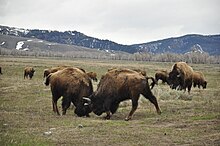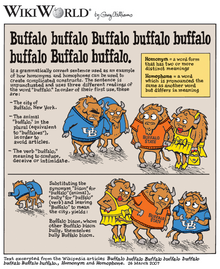Buffalo buffalo Buffalo buffalo buffalo buffalo Buffalo buffalo: Difference between revisions
Psychonaut (talk | contribs) fix paraphrase; this was for the ten-word version rather than the eight-word version |
Aaron McDaid (talk | contribs) Corrected paraphrasing. There are two orderings of upper- and lower- case. The paraphrases now matches the ordering used in the name of the article |
||
| Line 12: | Line 12: | ||
"'''Buffalo buffalo Buffalo buffalo buffalo buffalo Buffalo buffalo'''" is a [[Grammaticality|grammatical]] [[sentence (linguistics)|sentence]] in [[American English]], used as an example of how [[homonym]]s and [[homophone]]s can be used to create complicated linguistic constructs. It has been discussed in literature, in various forms, since 1967 when it appeared in [[Dmitri Borgmann]]'s ''[[Beyond Language: Adventures in Word and Thought]]''. |
"'''Buffalo buffalo Buffalo buffalo buffalo buffalo Buffalo buffalo'''" is a [[Grammaticality|grammatical]] [[sentence (linguistics)|sentence]] in [[American English]], used as an example of how [[homonym]]s and [[homophone]]s can be used to create complicated linguistic constructs. It has been discussed in literature, in various forms, since 1967 when it appeared in [[Dmitri Borgmann]]'s ''[[Beyond Language: Adventures in Word and Thought]]''. |
||
The sentence uses three distinct meanings of the word ''buffalo'': the city of [[Buffalo, New York]]; the somewhat uncommon verb ''to buffalo'', meaning "to bully or intimidate"; and the [[American bison|American buffalo]] (a species of [[bison]]). Paraphrased, the sentence means, "Bison from Buffalo that |
The sentence uses three distinct meanings of the word ''buffalo'': the city of [[Buffalo, New York]]; the somewhat uncommon verb ''to buffalo'', meaning "to bully or intimidate"; and the [[American bison|American buffalo]] (a species of [[bison]]). Paraphrased, the sentence means, "Bison from Buffalo, that bison from Buffalo bully, themselves bully bison from Buffalo." |
||
==Sentence construction== |
==Sentence construction== |
||
Revision as of 18:03, 26 December 2014

PN = proper noun
N = noun
V = verb
NP = noun phrase
RC = relative clause
VP = verb phrase
S = sentence
"Buffalo buffalo Buffalo buffalo buffalo buffalo Buffalo buffalo" is a grammatical sentence in American English, used as an example of how homonyms and homophones can be used to create complicated linguistic constructs. It has been discussed in literature, in various forms, since 1967 when it appeared in Dmitri Borgmann's Beyond Language: Adventures in Word and Thought.
The sentence uses three distinct meanings of the word buffalo: the city of Buffalo, New York; the somewhat uncommon verb to buffalo, meaning "to bully or intimidate"; and the American buffalo (a species of bison). Paraphrased, the sentence means, "Bison from Buffalo, that bison from Buffalo bully, themselves bully bison from Buffalo."
Sentence construction



The sentence is unpunctuated and uses three different readings of the word "buffalo". In order of their first use, these are:
- a. the city of Buffalo, New York, United States, which is used as a noun adjunct in the sentence and is followed by the animal;
- n. the noun buffalo, an animal, in the plural (equivalent to "buffaloes" or "buffalos"), in order to avoid articles;
- v. the verb "buffalo" meaning to bully, confuse, deceive, or intimidate.
Marking each "buffalo" with its use as shown above gives:
- Buffaloa buffalon Buffaloa buffalon buffalov buffalov Buffaloa buffalon.
The sentence uses a restrictive clause, so there are no commas, nor is there the word "which," as in, "Buffalo buffalo, which Buffalo buffalo buffalo, buffalo Buffalo buffalo." This clause is also a reduced relative clause, so the word that, which could appear between the second and third words of the sentence, is omitted.
Thus, the parsed sentence reads as a claim that bison who are intimidated or bullied by bison are themselves intimidating or bullying bison (at least in the city of Buffalo– implicitly, Buffalo, NY):
- Buffalo buffalo (buffalo from Buffalo NY) [that] Buffalo buffalo buffalo (that the buffalo from Buffalo NY bully) buffalo Buffalo buffalo (are bullying buffalo from Buffalo NY)
- [Those] buffalo(es) from Buffalo [that are intimidated by] buffalo(es) from Buffalo intimidate buffalo(es) from Buffalo.
- Bison from Buffalo, New York, who are intimidated by other bison in their community, also happen to intimidate other bison in their community.
- The buffalo from Buffalo who are buffaloed by buffalo from Buffalo, buffalo (verb) other buffalo from Buffalo.
- Buffalo buffalo (main clause subject) [that] Buffalo buffalo (subordinate clause subject) buffalo (subordinate clause verb) buffalo (main clause verb) Buffalo buffalo (main clause direct object).
The sentence can be clarified by substituting the synonym "bison" for the animal "buffalo", "bully" for the verb "buffalo", and "New York" to refer to the state of the city Buffalo:
- "New York bison New York bison bully, bully New York bison", or:
- "New York bison whom other New York bison bully, themselves bully New York bison".
Or, alternatively with the city name intact:
- "Buffalo bison Buffalo bison bully bully Buffalo bison".
Removing the classifier noun "Buffalo" (the city) further clarifies the sentence (note that the initial capital is retained as the common noun "buffalo" now starts the sentence):
- "Buffalo buffalo buffalo buffalo buffalo."
- "Bison [that other] bison bully [also] bully bison."
Usage
Thomas Tymoczko has pointed out that there is nothing special about eight "buffalos"; any sentence consisting solely of the word "buffalo" repeated any number of times is grammatically correct. The shortest is "Buffalo!", which can be taken as an imperative instruction to bully someone ("[You] buffalo!") with the implied subject "you" removed.[1]: 99–100, 104 Tymoczko uses the sentence as an example illustrating rewrite rules in linguistics.[1]: 104–105
Origin
The idea that one can construct a grammatically correct sentence consisting of nothing but repetitions of "buffalo" was independently discovered several times in the 20th century. The earliest known written example, "Buffalo buffalo buffalo buffalo", appears in the original manuscript for Dmitri Borgmann's 1965 book Language on Vacation, though the chapter containing it was omitted from the published version.[2] Borgmann recycled some of the material from this chapter, including the "buffalo" sentence, in his 1967 book, Beyond Language: Adventures in Word and Thought.[3]: 290 In 1972, William J. Rapaport, now a professor at the University at Buffalo but then a graduate student at Indiana University, came up with versions containing five and ten instances of "buffalo".[4] He later used both versions in his teaching, and in 1992 posted them to the LINGUIST List.[4][5] A sentence with eight consecutive "buffalo"s is featured in Steven Pinker's 1994 book The Language Instinct as an example of a sentence that is "seemingly nonsensical" but grammatical. Pinker names his student, Annie Senghas, as the inventor of the sentence.[6]: 210
Neither Rapaport, Pinker, nor Senghas were initially aware of the earlier coinages.[4] Pinker learned of Rapaport's earlier example only in 1994, and Rapaport was not informed of Borgmann's sentence until 2006.[4] Even Borgmann's example may not be the oldest: computational linguist Robert C. Berwick, who used a five-"buffalo" version in a 1987 book,[7]: 100 claims he had heard the sentence as a child ("before 1972, to be sure") and had assumed it was part of common parlance.[4]
Other words using the same pattern
Other English words can be used to make grammatical (but not necessarily meaningful) sentences of this form, containing endless consecutive repetitions. Any word that is both a plural noun and an uninflected transitive verb will work; for example, police, dice, perch. Adding a place name like Police, Poland, can allow for a sentence identical in structure to the Buffalo example, though not necessarily with uniform pronunciation: "Police police Police police police police Police police." With head (of cattle), as there is an adjective 'head', there is no capitalisation necessary: "Head head head head head head head head".
Any of these words can be mixed in any arbitrary pattern, such as "Police dice fish head buffalo", although only Police, head, and Buffalo can be parsed as adjectives.
A somewhat similar non-punctuated example is "James while John had had had had had had had had had had had a better effect on the teacher". This could concern a situation in an English class regarding the usage of the word had, and might be punctuated as, "James, while John had had 'had', had had 'had had'; 'had had' had had a better effect on the teacher."
In popular culture
An expanded form of the sentence is a lyric in the Alt-J song "Buffalo" from the soundtrack of Silver Linings Playbook.
See also
- Colorless green ideas sleep furiously
- Eats, Shoots & Leaves
- Lion-Eating Poet in the Stone Den
- List of linguistic example sentences
- That that is is that that is not is not is that it it is
- Semantic satiation
- Neko no ko koneko, shishi no ko kojishi
References
- ^ a b Thomas Tymoczko; James M. Henle (2000). Sweet reason: a field guide to modern logic (2 ed.). Birkhäuser. ISBN 978-0-387-98930-3.
- ^ Eckler, Jr., A. Ross (November 2005). "The Borgmann Apocrypha". Word Ways: The Journal of Recreational Linguistics. 38 (4): 258–260.
- ^ Borgmann, Dmitri A. (1967). Beyond Language: Adventures in Word and Thought. New York, NY, USA: Charles Scribner's Sons. OCLC 655067975.
- ^ a b c d e Rapaport, William J. (5 October 2012). "A History of the Sentence 'Buffalo buffalo buffalo Buffalo buffalo.'". University at Buffalo Computer Science and Engineering. Retrieved 7 December 2014.
- ^ Rapaport, William J. (19 February 1992). "Message 1: Re: 3.154 Parsing Challenges". LINGUIST List. Retrieved 14 September 2006.
- ^ Pinker, Steven (1994). The Language Instinct: How the Mind Creates Language. New York, NY, USA: William Morrow and Company, Inc.
- ^ Barton, G. Edward, Jr.; Berwick, Robert C.; Ristad, Eric Sven (1987). Computational Complexity and Natural Language. Cambridge, MA, USA: MIT Press.
{{cite book}}: CS1 maint: multiple names: authors list (link)
External links
- "Buffaloing buffalo" at Language Log, 20 January 2005
- Easdown, David. Template:PDF
Video clip
